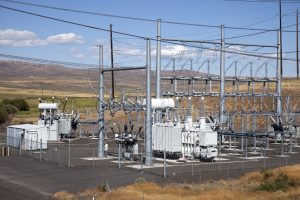How Does a Solar Farm Connect to the Grid?
All solar farms connect to a specific point on the electrical grid, the vast network of wires that connects every power generation plant to every home and business that consumes power. That point is called the “point of interconnection,” or POI. The POI is different for utility-scale versus community solar scale projects.
Utility-Scale vs. Community Solar
A community solar project is smaller than a utility-scale project. Project size is measured in terms of capacity. Community solar projects are typically 10 MWac or smaller. These projects almost always connect to a three-phased distribution line. A distribution line is conceptually the same as a transmission line but moves electricity at a much lower voltage. A distribution line must be within one mile of your property (or preferably much less) to make interconnection cost-effective.
Utility-scale projects connect by either connecting directly to a substation or tapping a transmission line (69 kV or higher).
Interconnecting With a Substation
You’ve probably seen substations before and did not realize what they were. They look something like this:

A typical utility substation
You will only find substations near transmission line towers. In more rural areas, they are typically at the outer edges of towns or close to power generating facilities, manufacturing plants, or drilling and mining operations. In urban areas, transmission lines are usually located along major roads or highways.
A substation is a fenced facility owned and operated by a utility. Its purpose is to convert high voltages to low voltages, or vice versa. Substations are necessary because of differences in voltages. Your home runs on 120 volts (AC), but electricity is transmitted over distances at much higher voltages to reduce power losses. Power generating plants such as solar farms output power at different voltages, too.
If the nearest transmission line to your property has a voltage of, say, 115 kV (115,000 volts), the output voltage from the solar farm needs to “step up” to 115 kV to feed power into it. Likewise, the power that line carries to a neighborhood 50 miles away eventually needs to “step down” in voltage so that homes can use it.
A substation is generally an ideal place for a solar farm to interconnect because the facility is already built and the design of these facilities makes it easier to interconnect.
Interconnecting With a Line Tap
The alternative POI to a substation is a line tap, which is essentially what it sounds like: “tapping into” a high-voltage power line, sometimes through a switchyard that will need to be constructed. This can be more expensive and technically more challenging.
One challenge is that the cost of interconnecting with a transmission line increases with the voltage of that line. It is not cost-effective to connect a small project to a very high-voltage transmission line. In addition, very large projects usually require a connection to a higher-voltage line. This means that just because you see a transmission line on or near your property, it may not be cost-effective or even technically possible to connect to it.
Distance Concerns
Unless the solar farm is right next to a transmission line or substation, a dedicated transmission line called a generation tie (“gen-tie”) will need to be built. These gen-ties cost approximately $1 million per mile to construct. The farther away the utility substation is from your property, the more expensive the gen-tie will be to build. There may be additional land costs, too, if the developer has to pay other landowners for the rights-of-way to cross their properties with the poles supporting the gen-tie.
These costs are almost always paid for by the solar developer, which makes the power generated by the farm more expensive, and therefore potentially less competitive against proposals from solar developers with properties that have closer substations. This, in turn, makes properties located far away from utility substations less appealing to solar developers, which means, all else equal, they would pay less to lease your land.
If you are really lucky, your property borders a substation or has a viable transmission line crossing it. This could make the interconnection cost quite low.
Capacity Issues
Just because you see a substation or a transmission or distribution line near your property does not necessarily mean interconnection will be possible. The infrastructure may not have enough capacity to handle the electricity currently flowing through them plus all of the electricity that the proposed solar farm would generate. The electrical equipment at some substations may also need to be upgraded to handle the additional interconnection of a solar farm. These are things that a solar developer will need to study before entering into a land lease agreement with you.